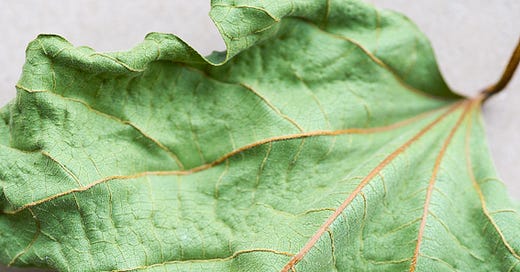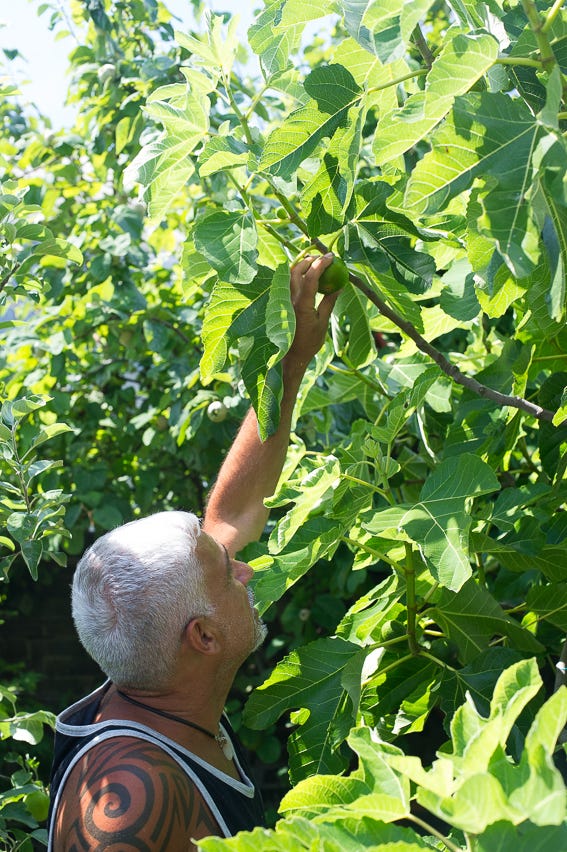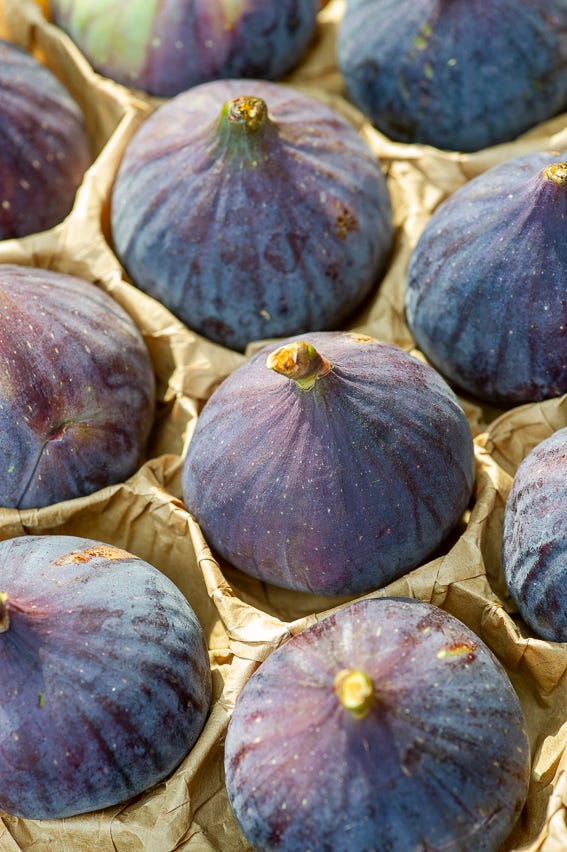In 1988, I ate my first fresh fig. It was handed to me by the person who’d grown it on the Greek island of Santorini. It was melting, succulent and with a sweet depth in that way muscovado is compared to white. It ruined me for figs for 24 years; in the years that followed, the ones I ate tasted not of luscious sunshine, but like tribute band supermarket peaches with a texture of rolled up football socks.
In 2012 that changed. I took the photographs for a book about original, beautiful allotments written by
. We went all over, visiting roof gardens in Brussels, dahlia allotments in the Midlands and the floating gardens of Amiens. Perhaps the most remarkable in terms of what an allotment can be, was by a roundabout in Tottenham, north London.It remains as perfect a marriage of the edible and ornamental as I’ve seen. We spent an afternoon with Chris Achilleos, whose creation it was, and - as is usual - when the book was published, the emails and phones rang with every TV researcher asking for contacts to feature on their show. A short while later, Chris’ allotment made it onto Gardeners’ World: click below to watch a short clip of his allotment.
As we left, Chris gave us a bagful of figs picked straight from the tree to eat on the train: I wasn’t looking forward to it - expecting more football socks - but did the polite thanking.
On the train, I took one from the bag and passed it to Lia and took one myself. I had the sense to place the open bag on the floor between our feet: sweet juice ran between my fingers, the fig overburdened by its perfection. It was by some distance the finest fig I’d ever eaten; my chin a glossy mess. Santorini had been trumped.
Sun, shelter, feeding through the summer months and choosing an excellent variety were, Chris assured me, the secrets to the best a fig could be.
Chris picking those figs at his allotment
With one thing and another, my resolve to plant a few only came to pass a few years ago and I’m still waiting on fruit, but - and this is a fine thing - I’ve discovered that as much as its a fruit I’ve been growing a herb.
Fig leaves. They made it into my HERB book where others (yes, you, lemon balm) didn’t.
As with bay, you generally don’t want to eat the leaf, you want the flavour infused. And what a flavour it is: a glorious coming together of my childhood favourites - popcorn, Shredded Wheat, coconut and candy floss.
Like banana or pandan leaves, they make a beautiful wrapping for fish, infusing their flavour as the fish cooks. Add a couple to rice as it simmers, and it will be transformed.
Rice pudding - and other dairy infusions - are lifted beautifully by the leaves’ flavour: think of them as biscuity bay leaves. Rice pudding made with fig leaves (dried or fresh) in the milk/cream is really something.
Unless I need the leaves to be flexible - wrapping fish etc - I toast them. You can do this in a dry, hot pan, but I prefer a slow oven where the heat is more even and scorchings fewer.
I’m not the only one who loves fig leaves in the kitchen: allow me to steer you towards the excellent
’s substack, where he has a recipe for a fig syrup that uses fresh rather than dried leaves; it’s deliciously different to mine with dried leaves, below.And there’s
’s wonderful substack where she has an incredible sounding Peach and fig leaf sorbet.Dried fig leaves
Rub a fig leaf and prepare to be underwhelmed by the scent, but give them a warm oven, and a fragrance fills the kitchen while it intensifies in the leaf itself.
Set the oven to 130°C. Lay the leaves on a baking sheet in a single layer, otherwise they’ll cling like a school-refusing koala to the bars of the shelf as they dry.
Place into the oven and allow them as long as it takes for them to curl at the fingertips until they resemble green poppadoms, their veins coppered in the heat. These dried leaves will keep for months in a sealed container, but their flavour is most intense during the first month.
By all means blitz these dried leaves into a powder to sprinkle on anything from ice cream to rice pudding.
Fig syrup
Makes 750ml approx
3 dried fig leaves – see above
500g white sugar
Place the sugar in a medium sized pan with 500ml (18fl oz) water and bring to a simmer, stirring to dissolve the sugar. Remove from the heat, add the fig leaves and allow to infuse. Taste using a teaspoon, and when the strength is as you’d like it, remove the leaves. The scent that fills the room when fig leaves are drying in a low oven is a weird coming together of popcorn, coconut and candy floss; it is this that enriches the sugar syrup, or the custard in the trifle on page xxx. This is one of my favourite syrups, great in cocktails, in the pina colada mojito (below), or poured over a cake.
Pina colada mojito
From my book SPICE/a cook’s companion
I should be calling this ‘The Rupert Holmes’ but as earworms go, Rupert Holmes' Escape (yes, everyone knows it as the Pina Colada Song) is pretty hard to winkle out once embedded, so I won’t.
You can use mint and fennel if you are without Korean mint, or grow anise hyssop, its very close relative, instead. And if, like Rupert, you’re not much into health food but are into champagne, you could try fizz in place of the rum.
6-7 chunks of pineapple
50ml fig leaf syrup (see above)
60ml white rum
60ml fresh pineapple juice
Juice of 1 lime
10 leaves of Korean mint (or mint and a few fronds of fennel instead)
Ice
Place the mint in a tall glass and bruise the leaves using the handle of a wooden spoon or a mortar to release the scent and flavour. Add the rum and ice, then the pineapple juice, syrup and lime juice, and stir.
Drink while reading the personal ads.
In fairness, figs from the shops can be much better than they were even a decade ago: in my experience, and imperfect as this index might be, those where someone has taken care to assume that they might benefit from not jostling each other in transit are often the best.









Fig leaves seem an exciting ingredient that has somehow slipped through my fingers. I don't encounter too many fig trees in Switzerland, but it does give me something to look forward to during my next visit to Italy...The syrup recipes sound tantalizing.
Speaking of fig trees... A chef friend in Italy once told me the sap from a broken fig branch can be used in the same way as animal rennet. I've never been able to verify this claim, though it does sound interesting and viable. Have you ever encountered this kind of use for fig sap?
Cool... Always trust the wisdom of an Italian chef... I wonder if it would also coagulate a plant-based alternative to milk... Maybe there's something there for me to investigate - now, where's the nearest fig tree?